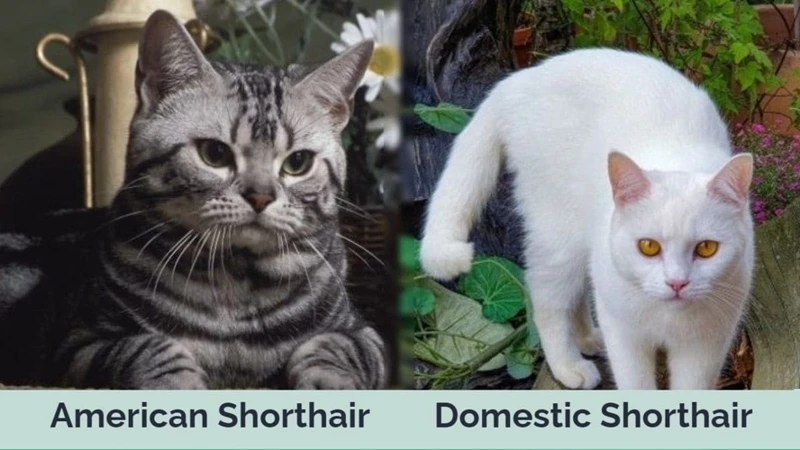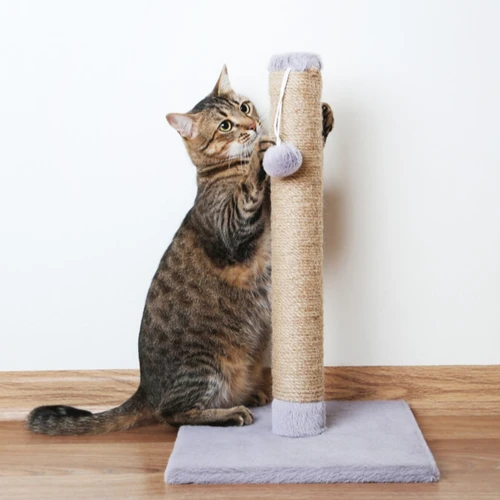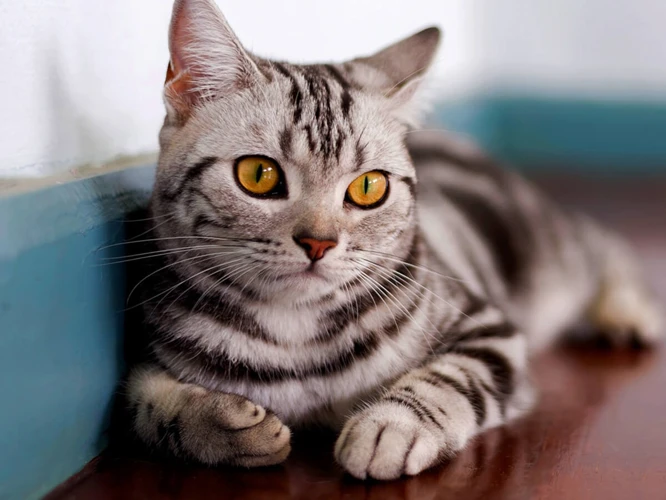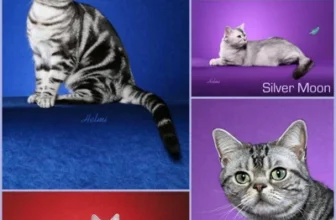You’re excited to bring home your new American Shorthair cat, but you quickly notice that they have a tendency to scratch at your furniture and belongings. As frustrating as it may be, it’s important to understand that scratching is a natural behavior for cats. Instead of getting upset with them, we can use positive reinforcement techniques to train them to use a scratching post instead. In this article, we’ll explore why American Shorthairs scratch, how to choose the right scratching post, and step-by-step instructions on how to train your furry friend using positive reinforcement. So, grab your treats and let’s get started!
Why Do American Shorthairs Scratch?

Cat owners often wonder why their furry companions insist on scratching everything in sight, from the furniture to the carpet. Understanding the reasons behind this behavior is an important step in training your American Shorthair to use the scratching post. Scratching is a natural and instinctual behavior that serves multiple purposes, such as marking territory, exercising, and stretching. In this section, we’ll delve deeper into the reasons why American Shorthairs scratch and how to use this knowledge to your advantage during training.
Instinctual Behavior
Scratching is a natural instinct for cats, and American Shorthairs are no exception. They have a natural urge to dig their claws into surfaces, and if you don’t provide them with an appropriate outlet for this behavior, they may turn to your furniture instead. Understanding this instinctual behavior is crucial to training your American Shorthair to use the scratching post.
Here are some key things to know about your cat’s instinctual scratching behavior:
- Scratching is a form of exercise: When your cat scratches, it’s not only to sharpen her claws, but also to stretch her muscles. This is why it’s crucial to provide a scratching post that is tall enough for her to stretch her entire body.
- Cats scratch to mark their territory: Scratching lets other cats know that this is their territory, and it also helps your cat feel more secure in her own space. A scratching post can be a great tool for helping your American Shorthair feel more at home in your house.
- Cats scratch to relieve stress: Scratching also has a soothing effect on cats, which can help to reduce stress and anxiety. This is another reason why providing an appropriate scratching surface for your American Shorthair is so important.
By understanding your cat’s natural scratching behavior, you can choose a scratching post that will truly meet her needs and help you succeed in training her to use it.
Marking Territory
When an American Shorthair scratches, one reason may be to mark their territory. By scratching, cats leave behind visual and scent markers that signal to other cats that this area is claimed. American Shorthairs have a strong sense of territoriality, and scratching is one way they establish their space. It’s important to understand that this behavior is instinctual and natural, so it’s not realistic to expect your cat to stop entirely. However, with some positive reinforcement training, you can redirect them towards a more appropriate area for scratching.
Understanding why your American Shorthair scratches can help you solve problem scratching. By providing them with a designated area for scratching, you are giving them a place where they can engage in this activity without damaging furniture or carpeting. By choosing a sturdy, tall scratching post, you are also providing them with the chance to stretch and strengthen their muscles. This not only benefits their health but also their mental well-being.
| Pros of Optional Training Methods | Cons of Omitting Training Techniques |
|---|---|
| Cat learns to identify the desired scratching surface | Damaged furniture and flooring |
| Promotes healthy muscle development | Decreased lifespan of furniture and flooring |
| Lessens furniture/turf wars between cat and owner | Aggression from cat when owner confronts scratching behavior |
It’s important to understand that training is not just about stopping bad behavior, but also promoting good behavior. By providing your American Shorthair with positive reinforcement training, you are establishing yourself as a trusted and caring owner. This can lead to a stronger bond with your cat and a happier environment for everyone.
If your cat has been scratching inappropriately, start by providing a scratching post near the area they like to scratch. Regularly clip their nails to prevent them from hurting themselves or damaging surfaces. Use deterrents to keep them away from areas you don’t want them to scratch. Consider introducing catnip to the scratching post to make it more enticing. Reinforce good behavior by giving treats when they use the scratching post appropriately. For more detailed information on positive reinforcement training techniques, check out Using Treats for Training American Shorthairs and American Shorthair Positive Reinforcement Commands. Remember to stay patient and persistent when training your cat, and you will be rewarded with a well-behaved and happy American Shorthair.
Exercising and Stretching
As much as we might not understand it, scratching is a natural and instinctual behavior in American Shorthairs. It not only allows them to mark their territory but also to stretch and exercise their muscles. Providing your cat with a scratching post that meets their needs is essential in preventing them from damaging your furniture and other household items.
Exercising and Stretching is a crucial reason why your American Shorthair needs a scratching post. As cats scratch, they are not only pulling and flexing their muscles, but they are also releasing tension. It is not uncommon to see your cat stretching up on their hind legs to scratch on a vertical post, as this allows them to work their core and leg muscles.
Providing a horizontal scratching post is also beneficial for your cat as it allows them to stretch their spine and shoulders. A scratching post that is sturdy and tall enough for your cat to stretch to their full height is an excellent way to keep your American Shorthair healthy and happy.
Here are some additional tips to ensure your cat gets the most out of their scratching post:
| Tip | Description |
|---|---|
| Catnip | Adding a little bit of catnip to the scratching post can help entice your cat to use it. Not all cats respond to catnip, so it’s essential to monitor your cat’s behavior when you introduce it. |
| Trimming Nails | Trimming your cat’s nails is a great way to keep them from scratching your furniture. However, it is essential to provide them with a scratching post as well to meet their natural instincts. |
| Deterrents | Using deterrents such as double-sided tape or aluminum foil on your furniture can help train your cat to use their scratching post instead. However, it is crucial to remember to use positive reinforcement alongside these deterrents. |
| Stay Patient and Persistent | Training your American Shorthair to use a scratching post takes time and patience. Consistency is key, and it’s essential to reward good behavior and discourage bad behavior consistently. For more information on positive reinforcement training, check out our article on Benefits of Positive Reinforcement Training for Anxious Cats. |
By choosing the right scratching post and providing your American Shorthair with a cat-friendly environment, you can prevent them from damaging your furniture and enjoy a happy and healthy cat.
Choosing the Right Scratching Post

Choosing the perfect scratching post for your American Shorthair may seem like a daunting task. With so many options available, it’s essential to consider several factors to ensure your cat will use it regularly. By selecting the right size and type of material, determining the post’s orientation, and choosing the best location for it, you can improve your chances of success in training your cat to use the scratching post. In this section, we will explore these factors and provide tips and tricks to make your American Shorthair’s scratching post an irresistible place to scratch.
Size and Type of Material
When selecting a scratching post for your American Shorthair, the size and type of material are two crucial factors to consider. A scratching post that is too small or unstable may not be satisfying for your cat, while a post made of the wrong materials may not appeal to your cat’s natural scratching instincts.
Size: The scratching post should be tall enough for the cat to fully stretch and scratch vertically. It should also be sturdy enough to withstand the cat’s weight and force when scratching. A post that is too small or wobbly may not be satisfying for your cat or may even tip over, which can lead to injuries.
Type of material: American Shorthairs generally prefer a post made of a rough and durable material, like sisal rope or corrugated cardboard. These materials allow the cat to dig their claws in and scratch to their heart’s content. Soft fabrics, like carpet or velvet, can be tempting to claw at, but they don’t provide the right texture for scratching, which can lead to frustration and further furniture damage.
When choosing the right materials, consider the preferences of your American Shorthair. Some cats may prefer a scratching post made out of wood or other materials, while others may prefer a post that hangs from a doorframe or attaches to a wall.
The size and type of material play a significant role in the effectiveness of the scratching post. Investing in a post that is both tall and sturdy, made of rough and durable materials that appeal to your cat’s natural instincts, can go a long way in preventing them from damaging your furniture and carpets.
Vertical or Horizontal?
When choosing a scratching post for your American Shorthair, it’s important to consider whether you want a vertical or horizontal post. Each option has its benefits, and the decision ultimately comes down to your cat’s preferences.
Vertical:
- A vertical post is great for cats who like to stretch high and scratch their claws downward.
- It takes up less floor space, which can be ideal for smaller homes or apartments.
- It can also double as a great way for your cat to stretch their back muscles and get some exercise.
Horizontal:
- A horizontal post is great for cats who like to scratch while lying down or crouching.
- It can also be helpful for cats who are older or have arthritis because they don’t have to stand up to scratch.
- Some horizontal posts even come with interactive toys attached, providing your cat with even more stimulation.
Ultimately, whether you choose a vertical or horizontal post, what’s most important is that it has a sturdy base, is made of durable material, and is tall enough for your cat to fully stretch out. Take into consideration your cat’s scratch preferences and behavior when making your decision.
Location, Location, Location
When choosing the right scratching post for your American Shorthair, location is an important factor to consider. You want to make sure that your cat’s scratching post is placed in a spot where they will enjoy using it and where it will be easy for them to access whenever they feel the urge to scratch. Here are some tips for finding the perfect location for your cat’s scratching post:
- Choose a visible area: Cats like to scratch in visible areas, so make sure that the scratching post is placed somewhere where your cat can see it. This can be in a living room, bedroom, or other high-traffic area.
- Keep it away from favorite resting spots: Cats like to scratch when they wake up from a nap, make sure to place the scratching post away from their favorite resting spots to prevent them from accidentally scratching furniture or other surfaces that they like to nap on.
- Place it near existing scratch marks: If your cat already has a favorite spot to scratch, or has been using your furniture as a scratching post, try placing the new scratching post in the same area to encourage them to switch over.
- Make sure it’s stable: Your cat will want to scratch with enthusiasm, so make sure that the scratching post is stable and won’t topple over when they use it. You can either choose a heavy, sturdy scratching post or attach it to a wall for extra support.
By keeping these tips in mind, you will be able to find the perfect location for your cat’s scratching post and encourage them to use it regularly. Remember, consistency is key when it comes to training your cat to use their scratching post, so make sure to reinforce positive behavior with rewards and discourage negative behavior using gentle redirection techniques.
Positive Reinforcement Training

As cat owners, we want to ensure that our furry friends are happy and healthy. One way to achieve this is by training our American Shorthairs to use the scratching post. However, traditional methods of punishment and deterrence can cause more harm than good and strain the bond between us and our pets. That’s where positive reinforcement comes in. This method focuses on rewarding your cat for good behavior, creating a more positive association with the scratching post, and building trust between you and your cat. In this section, we’ll walk you through the steps of positive reinforcement training.
What is Positive Reinforcement?
Positive reinforcement is a training technique that involves rewarding behavior you want to encourage. It works by offering a desirable consequence for a certain behavior, which makes the behavior more likely to occur again in the future. This type of training is based on the idea that animals, including cats, respond better to positive stimuli than negative ones.
Examples of Positive Reinforcement
Here are some examples of positive reinforcement techniques that can be used when training your American Shorthair to use the scratching post:
- Giving treats – Rewards such as catnip or tiny pieces of food can be used to encourage good behavior. Whenever your cat uses the scratching post, give them a treat to reinforce the behavior.
- Offering praise – Cats respond well to positive feedback, so make sure to praise them whenever they use the scratching post. Use a happy tone of voice and pet them gently to let them know you are pleased with their behavior.
- Providing toys – Toys can be used as a reward for good behavior during training. For example, if your cat uses the scratching post instead of your furniture, give them one of their favorite toys to play with.
Benefits of Positive Reinforcement Training
Using positive reinforcement techniques has several benefits that make it a great choice for training your American Shorthair to use the scratching post:
- It is humane – Positive reinforcement training does not involve punishment or physical force, which can harm your cat and damage your relationship with them.
- It is effective – Studies have shown that positive reinforcement training is more effective than negative reinforcement or punishment when it comes to changing behavior in cats.
- It strengthens your bond – When you use positive reinforcement, you establish a bond of trust and mutual respect between you and your cat. This can lead to a stronger relationship overall.
Conclusion
Positive reinforcement training is a great way to encourage your American Shorthair to use the scratching post. By using rewards such as treats, praise, and toys, you can teach your cat to associate the scratching post with positive experiences. This will make it more likely that they will use the post in the future, and less likely that they will scratch your furniture. Additionally, using positive reinforcement has several benefits for both you and your cat, including strengthening your bond and promoting humane training methods.
Introducing Your Cat to the Scratching Post
Cats can be stubborn creatures, so introducing them to a scratching post may take some patience. Here are some steps to get your American Shorthair comfortable with their new post:
| Step 1: | Place the scratching post in a central location in your home. This will make it more likely for your cat to find and use it. |
| Step 2: | Entice your cat to approach the post by using a toy or catnip. Place the toy or catnip on or near the post to encourage them to investigate. |
| Step 3: | Gently pick up your cat and place them near the post. Encourage them to sniff and scratch the post. Be patient and don’t force them to do anything. |
| Step 4: | Repeat steps 2 and 3 multiple times a day for a few days. This will help your cat associate the post with positive experiences. |
Remember to always use positive reinforcement techniques, such as praise and treats, when your cat scratches the post. This will encourage them to continue using it and will strengthen the bond between you and your feline friend.
Rewarding Good Behavior
One of the most important aspects of training your American Shorthair to use the scratching post is rewarding good behavior. When your cat starts using the scratching post instead of your furniture, it’s time to celebrate! Here are some tips for rewarding your cat and reinforcing that scratching the post is the desired behavior:
| Reward type | Explanation |
|---|---|
| Treats | Give your cat a small treat every time they use the scratching post. This can be a piece of kibble or a specially designed cat treat. Be sure not to overfeed your cat during training. |
| Praise | Verbal praise is an important part of positive reinforcement. When your cat scratches the post correctly, use a happy tone of voice to tell them “good job!” or “you’re such a good kitty!” |
| Playtime | After your cat uses the scratching post, play with them using their favorite toy. This will train them to associate the scratching post with fun and games. |
Remember, consistency is key when rewarding good behavior. Make sure you use the same reward every time and give it immediately after the desired behavior occurs.
Discouraging Bad Behavior
Cats can be stubborn creatures, and they may not take to the scratching post immediately. When your American Shorthair tries to scratch something they shouldn’t (like furniture or carpets), it’s important to discourage this behavior. However, it’s essential to do this in a way that doesn’t scare or harm your cat.
One way to discourage bad behavior is to use a deterrent, like double-sided tape or aluminum foil, on the surface of a piece of furniture. When your cat tries to scratch it, they will be dissuaded by the texture or sound. Another option is to use a spray that cats find unpleasant, like a citrus or vinegar solution. Be sure to test any deterrents in a small, inconspicuous area first to ensure it won’t damage the furniture.
It’s important to never physically punish your cat for scratching behavior, as this can damage your relationship with your pet and lead to fear or aggression.
Instead, redirect your cat to the scratching post. If you catch your cat scratching the furniture, calmly pick them up and move them to the scratching post. Once they start scratching the post, praise and reward them with a treat or positive attention.
Another way to discourage bad behavior is to make the furniture less appealing. Place a scratching post nearby or cover the furniture with a fabric that your cat won’t be interested in scratching. Providing plenty of toys and playtime can also reduce your cat’s desire to scratch.
Remember to be patient and consistent with your cat’s training. It may take time for them to learn the appropriate place to scratch, but with positive reinforcement and consistent training, your American Shorthair can learn to use their scratching post instead of damaging your furniture.
| Do | Don’t |
|---|---|
| Use a deterrent like double-sided tape or a citrus spray | Physically punish your cat for scratching behavior |
| Redirect your cat to the scratching post | Ignore or neglect your cat’s scratching behavior |
| Make furniture less appealing by covering it with an unappealing fabric | Get frustrated or angry with your cat’s scratching behavior |
| Provide plenty of toys and playtime | Give up on training your cat to use the scratching post |
Consistency is Key
Consistency in training is crucial when it comes to teaching your American Shorthair to use the scratching post. Here are some key points to keep in mind:
- Set aside regular training time: Find a time each day to work with your cat on using the scratching post. This will help establish a routine and make it easier for your cat to learn.
- Use the same commands consistently: Whether you use “scratch post” or “touch” to prompt your cat to use the scratching post, make sure to use the same command every time. This will reduce confusion and help your cat learn the expected behavior.
- Be patient and persistent: Training may take weeks or even months, especially if your cat has already developed a habit of scratching in other locations. Stick with the training and avoid getting frustrated. Cats can sense your emotions and may become less willing to learn if you are visibly upset.
- Offer rewards and praise consistently: When your cat scratches on the scratching post, make sure to give a consistent reward, such as a treat or playtime. Praise your cat in a consistent way as well, such as saying “Good job!” in a happy tone of voice.
By being consistent in your training, you’ll be teaching your American Shorthair to use the scratching post effectively and reliably. Remember, cats respond well to positive reinforcement and consistent training, so keep up the good work!
Other Tips and Tricks
As a cat owner, you likely know that each feline has their quirks and preferences when it comes to scratching. In addition to the techniques discussed in the previous sections, there are some other tips and tricks that can help encourage your American Shorthair to use their scratching post. These methods aim to make the scratching post even more appealing to your cat and minimize undesirable scratching on furniture or carpets. Let’s take a look at some of these helpful strategies below.
Adding Catnip to the Scratching Post
One way to encourage your American Shorthair to use their scratching post is by using catnip. Catnip is a natural herb that is completely safe for cats when used in moderation. When cats smell or ingest catnip, it can have a euphoric effect on them, making them playful and content. Here are a few steps you can follow to add catnip to the scratching post:
- Start by placing your cat’s scratching post in an area they already frequent, such as near their favorite sleeping spot.
- Take some fresh or dried catnip and sprinkle it onto the scratching post. You can also rub it into the fibers of the post to release the scent.
- Encourage your cat to investigate the scratching post by using a toy or treat to lure them over to it.
- If your cat shows interest in the scratching post, give them plenty of praise and treats as a reward.
- Repeat this process every few days or whenever you notice your cat starting to lose interest in the scratching post.
It’s important to note that not all cats have a strong reaction to catnip, so this method may not work for every American Shorthair. Additionally, some cats may be sensitive to catnip and may have an adverse reaction. If you’re unsure whether or not your cat will react positively to catnip, start by using a small amount and monitor their behavior closely. As always, consult with your veterinarian before introducing anything new to your cat’s routine.
Trimming Your Cat’s Nails
Keeping your American Shorthair’s nails trimmed can help prevent damage to your furniture and carpets, as well as keep your cat healthy. However, it can be a tricky process and requires patience, so it’s important to do it properly. Here are some tips for trimming your cat’s nails:
| Tip | Description |
|---|---|
| 1. Get Your Cat Used to Handling Their Paws | Before you attempt to trim your cat’s nails, get them used to having their paws handled. Start by touching their paws gently while giving them treats or playing with them, so they associate paw handling with positive experiences. |
| 2. Use Proper Tools | Invest in a pair of cat-specific nail clippers, as human clippers can be too large and cause injury. Avoid using scissors, as they can crush the nail and be painful for your cat. |
| 3. Choose a Calm Environment | Choose a quiet room where you and your cat can be calm and relaxed. Create a comfortable space for your cat, such as a blanket or cushion, and have treats on hand to reward them for good behavior. |
| 4. Start Slowly | Start by trimming only one or two nails at a time until your cat gets used to the process. Gently hold their paw and extend the nail by pressing it with your finger. Identify the quick (pink area), which is where the nerves and blood vessels are. Make sure to only trim the tip of the nail, avoiding the quick to prevent injury and bleeding. |
| 5. Use Positive Reinforcement | Offer your cat treats or give them praise after each successful nail trim to create a positive association with the process. This will make them more likely to allow you to trim their nails in the future. |
Remember to be patient and gentle, and never force your cat to have their nails trimmed. If you’re struggling or your cat is particularly resistant, consider taking them to a professional groomer or veterinarian for assistance. With practice and consistency, your cat will become more comfortable with nail trimming and it can become a stress-free part of your grooming routine.
Using Deterrents
If your American Shorthair stubbornly refuses to use the scratching post despite your best efforts, it may be time to try a deterrent. Here are some common deterrents you can use to keep your cat away from furniture and redirect their scratching behavior:
- Double-Sided Tape: Cats don’t like the feeling of sticky surfaces on their paws, so placing double-sided tape on furniture can discourage scratching. Just make sure to remove the tape before guests come over!
- Bitter Spray: Many pet stores carry sprays designed to taste unpleasant to cats. Simply spray the deterrent on the piece of furniture you want to protect and watch your cat keep their distance.
- Plastic Mats: Another option is to cover the furniture in plastic mats with the nubby side up. These mats are uncomfortable for cats to walk on and can deter scratching.
- Noise Makers: If your cat responds well to noise, try placing a motion-activated noise maker near the furniture. The sudden sound can startle your cat and discourage scratching.
Keep in mind that while deterrents can be effective, they should only be used as a last resort. Remember, positive reinforcement training is the best way to encourage your American Shorthair to use the scratching post instead of your furniture. If you’re patient and persistent, you can train your cat to be a happy and healthy scratcher!
Stay Patient and Persistent
Patience and persistence are key when it comes to training your American Shorthair to use the scratching post. Remember, cats are creatures of habit with their own personalities and preferences. Some kitties may take to their scratching post right away, while others may need a little more coaxing.
Do not give up if your cat does not immediately take to the scratching post. It may take weeks or even months before your American Shorthair becomes a frequent user of the post. During this time, it’s important to remain positive and encouraging, while also being consistent with your training.
To help keep yourself on track and stay motivated, consider keeping a log of your cat’s progress. Document successes and setbacks, and adjust your training strategy as necessary to better suit your cat’s individual needs and learning style.
Remember to always be patient with your cat and never resort to punishment or physical force. These methods are not only cruel, but they can also be counterproductive to your training efforts. Instead, focus on positive reinforcement techniques, rewarding good behavior and ignoring bad behavior.
Lastly, it’s important to stay persistent in your efforts to train your American Shorthair to use the scratching post. Even if your cat has been using the post for weeks or months, it’s important to continue to reinforce this behavior and provide positive reinforcement. This will help ensure that your cat continues to use the scratching post, rather than engaging in destructive scratching elsewhere in the home.
| Patience | Persistence |
|---|---|
| Do not give up | Keep a log of progress |
| Remain positive and encouraging | Adjust training strategy as necessary |
| Be patient and never resort to punishment or force | Stay persistent in reinforcing good behavior |
Conclusion
After going through the entire article, you now have a good understanding of how to train your American Shorthair cat to use a scratching post. It’s important to remember that scratching is a natural and instinctual behavior for cats, and it’s up to us as pet owners to provide them with the right tools to do so.
Choosing the right scratching post is essential – you want to choose something that your cat will enjoy using. Keep in mind the size and material of the post, as well as whether your cat prefers a vertical or horizontal surface. Location is also important – make sure the scratching post is placed in a spot your cat likes to spend time in.
Positive reinforcement training is a great approach to use when teaching your cat to use the scratching post. By rewarding good behavior and discouraging bad behavior, you can gradually train your cat to use the post consistently.
Other tips can also be helpful, such as adding catnip to the post, trimming your cat’s nails, and using deterrents to discourage scratching in unwanted areas. Remember, patience and persistence are key when training your cat.
In conclusion, with the right tools, training approach, and a bit of patience, you can successfully train your American Shorthair cat to use a scratching post. Keep in mind the natural instincts of your cat, and provide them with the opportunity to exercise those instincts in a way that is both safe and enjoyable for both them and you. With time and effort, you’ll be able to enjoy a happy and well-behaved feline companion.
Frequently Asked Questions
How do I know if my American Shorthair needs a scratching post?
If your American Shorthair is scratching up your furniture or carpet, it’s a sign that they need a proper outlet for their scratching behavior.
Do all American Shorthairs like scratching posts?
No, not all cats are the same! While scratching posts are generally well-received by cats, some may prefer different types of scratching surfaces.
Can I train an adult American Shorthair to use a scratching post?
Yes, even older cats can learn new tricks with a little patience and persistence.
What kind of scratching post material is best for my American Shorthair?
Most cats prefer a rough texture that allows them to dig their claws in and scratch. Sisal rope and cardboard are popular options.
How tall should the scratching post be?
It should be tall enough for your cat to fully stretch out their body and reach up high, as this is a natural behavior for them.
Should I place the scratching post near my American Shorthair’s bed or food bowl?
No, it’s recommended to place the scratching post in a separate area where your cat can scratch and play without feeling threatened or overwhelmed.
What treats should I use to reward my American Shorthair during training?
Try using small, soft treats specifically designed for cats. Avoid anything too large or hard that could be a choking hazard.
What should I do if my American Shorthair keeps ignoring the scratching post?
Try moving the scratching post to a different location or experimenting with different materials. It may take some trial and error to find the right fit for your cat.
Should I punish my American Shorthair if they scratch something they shouldn’t?
No, punishment can be counterproductive and damage the trust and bond between you and your cat. Instead, redirect their attention to a suitable scratching surface.
Is it normal for my American Shorthair to continue scratching after being trained to use a scratching post?
Yes, scratching is a natural behavior for cats and they may continue to do so even if they have a designated scratching post. However, with consistent training and positive reinforcement, they should gradually prefer the scratching post over other surfaces.







